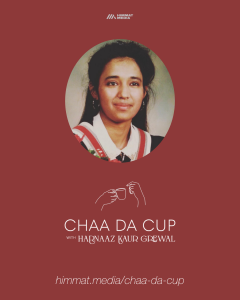Chaa Da Cup with Harnaaz Kaur Grewal
Vancouver-based Digital Marketing Agency and Think Tank Himmat Media teamed up with University of British Columbia – Okanagan Masters in Social Work Student, Harnaaz Kaur Grewal (Naaz), to launch a first-of-its-kind research project titled “Chaa Da Cup with Harnaaz Kaur Grewal.”
The research, conducted by Grewal – founder and project lead of the project, addresses key gaps in overall social systems that marginalise vulnerable populations such as women of colour. Specifically, this project addresses key gaps in the mental health services system and within cultural society for South Asian women and highlights the need for a model focused on action-based system reform.
Key takeaways from this study include:
- South Asians are the largest visible minority in Canada and report one of the highest rates of anxiety among minorities – however, mental health programmes are maladaptive of creating effective counselling methods and practices that block access to mental health services.
- A lack of cultural sensitivity and awareness are fundamental reasons why women of colour are less likely to receive counselling services. Systemic factors such as racial and gender based discrimination further stigmatise women of colour and create barriers to accessing services.
- More women of colour must be included in programme inception, development and decision making processes when it comes to designing mental health services especially those centred around supporting IBPOC women.
Above all else this project allows for its readers to learn the intricacies and connections between race, gender, generational trauma and how they intersect to influence how racialized women in Canada navigate their day to day lives. To view the project in its entirety, please view Chaa Da Cup at the link here. Alternatively, you can download the media kit for this project, including its full press release at the link here.
We are looking forward to hearing from you and have high hopes that your organisation will help us amplify and action the recommendations and critical gaps addressed in this study. Please do not hesitate to reach out to us for more information.
About the Contributor
Individuals tend to consider their immediate surroundings when reflecting on the physical environment. However, I believe one’s environment goes beyond the physical space and fosters a psychological connection that influences the ways in which we form our identities. The reciprocal relationship between one’s multifaceted identity with the physical place is embedded from the day we are born. As for me, I grew up in Surrey; a city where most of the population looked like me, acted like me and partook in the same activities, events, and festivities. My environment was a place of safety and security as it nourished a physical and psychological space where I could be myself without judgment or discrimination.
In 2012, I moved away from my family to the Interior, specifically Kelowna, and Vernon. While the physical space around me was similar to Surrey, the connection to the space felt disjointed and disconnected. The Interior had so much to offer, yet I felt unwelcomed. It took some time for me to acclimate to my new surroundings and community. Over time I started to find the comfort I yearned for by visiting the local Sikh gurdwaras (temples). As I began to attend South Asian and Western events, I found a balance between the comforts of my old “place” back home and the new one in the Interior. I saw more of these events be prevalent in the physical space around me and while there was increased acceptance, I continued to see a rise in hate towards South Asian dysphoria locally and nationally.
My place of origin nurtured strong cultural ties and helped shape my identity as a Sikh Punjabi woman. Sikhs are a collectivist community; when one person is hurting, the pain causes a ripple effect through the rest of the community. So, when I started to see a rise in hate towards my fellow South Asian brothers and sisters, I knew I needed to spring into action, and that is one of the reasons why Chaa da Cup with Harnaaz Kaur Grewal was created. I spoke with various South Asian women about their experiences with racism and sexism in their places of residence, and a pattern started to emerge. The physical space that surrounded the participants informed the ways in which they interacted with their community. Some came from larger cities where diversity was prevalent. Others came from smaller urban towns where they felt disconnected like I did when I first moved to the Interior. Prior to the conversations with the participants, I never considered how much power there is in “place”.
The Power of Place plays a role in determining the symbolic efficacy of a location. It can be both a space of freedom and public constraint, just as the women discussed in the project. It is also a space that fosters one’s formation of identity. Therefore, the public space is one in which members of society must come together to share and learn from one another, to grow despite our differences, and foster a welcoming and inclusive environment. Something as simple as a cup of tea with women from various parts of Canada helped do exactly that. In the future, I hope to continue creating a safe space through the Chaa da Cup platform and similar projects in which we can celebrate our differences in origin and amplify the voices of marginalized and equity-seeking populations.


Image retrieved from https://himmat.media/chaa-da-cup

